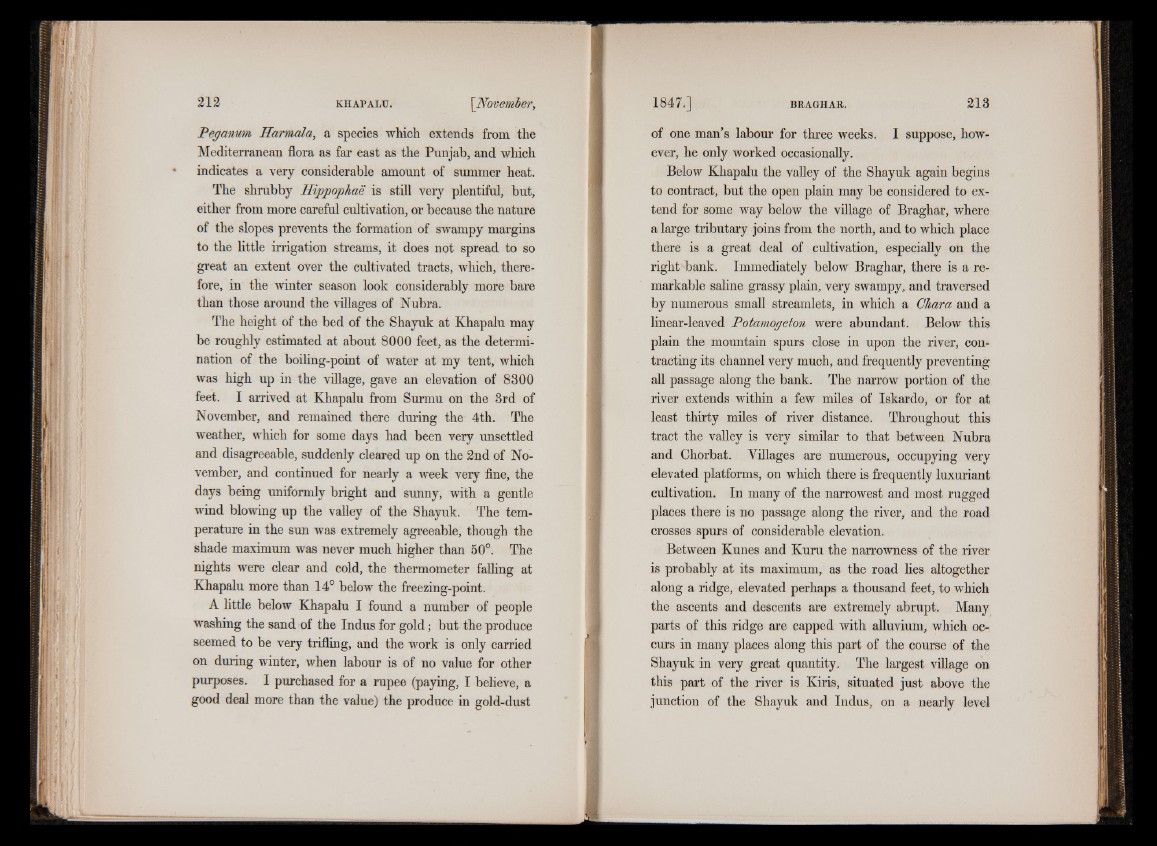
Peganum Harmala, a species which extends from the
Mediterranean flora as far east as the Punjab, and which
indicates a very considerable amount of summer heat.
The shrubby Ilippophae is still very plentiful, but,
either from more careful cultivation, or because the nature
of the slopes prevents the formation of swampy margins
to the little irrigation streams, it does not spread to so
great an extent over the cultivated tracts, which, therefore,
in the winter season look considerably more bare
than those around the villages of Nubra.
The height of the bed of the Shayuk at Khapalu may
be roughly estimated at about 8000 feet, as the determination
of the boiling-point of water at my tent, which
was high up in the village, gave an elevation of 8300
feet. I arrived at Khapalu from Surmu on the 3rd of
November, and remained there during the 4th. The
weather, which for some days had been very unsettled
and disagreeable, suddenly cleared up on the 2nd of November,
and continued for nearly a week very fine, the
days being uniformly bright and sunny, with a gentle
wind blowing up the valley of the Shayuk. The temperature
in the sun was extremely agreeable, though the
shade maximum was never much higher than 50°. The
nights were clear and cold, the thermometer falling at
Khapalu more than 14° below the freezing-point.
A little below Khapalu I found a number of people
washing the sand of the Indus for gold; but the produce
seemed to be very trifling, and the work is only carried
on during winter, when labour is of no value for other
purposes. I purchased for a rupee (paying, I believe, a
good deal more than the value) the produce in gold-dust
of one man’s labour for three weeks. I suppose, however,
he only worked occasionally.
Below Khapalu the valley of the Shayuk again begins
to contract, but the open plain may be considered to extend
for some way below the village of Braghar, where
a large tributary joins from the north, and to which place
there is a great deal of cultivation, especially on the
right bank. Immediately below Braghar, there is a remarkable
saline grassy plain, very swampy, and traversed
by numerous small streamlets, in which a Chara and a
linear-leaved Potamogeton were abundant. Below this
plain the mountain spurs close in upon the river, contracting
its channel very much, and frequently preventing
all passage along the bank. The narrow portion of the
river extends within a few miles of Iskardo, or for at
least thirty miles of river distance. Throughout this
tract the valley is very similar to that between Nubra
and Chorbat. Villages are numerous, occupying very
elevated platforms, on which there is frequently luxuriant
cultivation. In many of the narrowest and most rugged
places there is no passage along the river, and the road
crosses spurs of considerable elevation.
Between Kunes and Kuru the narrowness of the river
is probably at its maximum, as the road lies altogether
along a ridge, elevated perhaps a thousand feet, to which
the ascents and descents are extremely abrupt. Many
parts of this ridge are capped with alluvium, which occurs
in many places along this part of the course of the
Shayuk in very great quantity. The largest village on
this part of the river is Kiris, situated just above the
junction of the Shayuk and Indus, on a nearly level